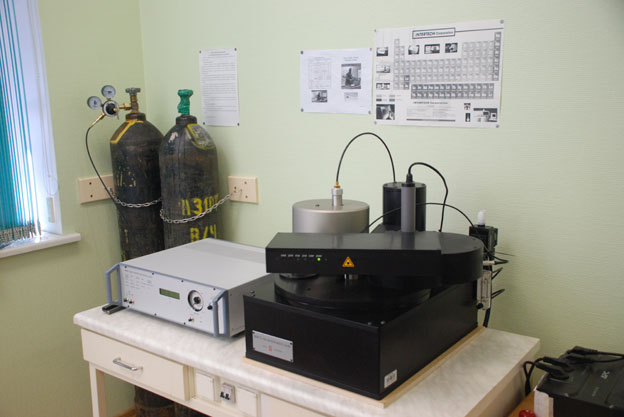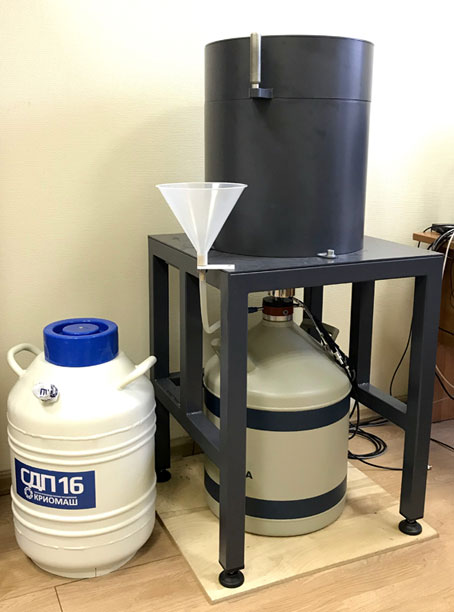Description
Applicability. The radiocarbon method is a traditional method for dating and correlating Quaternary deposits. However, the possibilities of its application are limited due to short chronological interval of up to 40-50 kyr and high requirements to the burial conditions of dated organic material. In this situation, the method of optically stimulated luminescence (OSL) is the only alternative to dating sediments with an age of more than 50 kyr.
Method description. The OSL dating is based on the assessment of the absorbed radiation dose over the period of sediment burial. The age is calculated by dividing the absorbed dose by the dose rate (accumulation rate). One of the main advantages of the method is the wide distribution of material suitable for dating. This can be quartz or feldspar grains.
The only limitation is the necessary setting to zero of the old light sum stored in mineral grains before starting the counter. The latter means that before burial, the time of which is determined by OSL age, it is imperative to “bleach" sand grains in the light. Bleaching is obvious for subaerial sediments, quite real for channel, floodplain, offshore and similar sediments, but problematic for deep-water formations redeposited exclusively outside the sunlit shallow water, at depths of more than 15-30 m. Minor errors can be caused by poorly controlled diagenetic changes in rock moisture, nuclide migration, signal instability.
OSL age values are usually given with standard deviations of laboratory measurements. It is believed that the reliability of OSL dating for quartz is limited to 100-150 kyr. Feldspar dating increases the interval to 400–500 kyr. When using the OSL method, as well as other dating methods, statistics is important. For a reliable estimate of the age of a sand member, it is necessary to have a minimum of three OSL dates, of which at least two should have close values.
It should be borne in mind that exact OSL dates are much closer to astronomical ages than radiocarbon ones. For the Pleistocene rocks, the latter give an estimate reduced by several thousand years as compared to the calendar age, and due to the nonlinearity of this deviation, the calibration of old radiocarbon dates is still problematic.
Experience of using. In Russia, the OSL method was first widely used in the Arctic, when in 1993, major international studies of the Pleistocene of northern Eurasia were launched. Although the results were excellent and the method was in demand in geology, archeology and other sciences that study the Anthropogene, in Russia, the technical base for OSL dating has only recently been created. The first OSL laboratory in Russia has been set up at the Karpinsky Institute in October 2017.
Investigations
OSL Laboratory performs the following investigations:
1) Dating the Quaternary rock samples using subsamples of quartz grains (fractions of 180-250, 90-180, 63-90 µm) using the SAR measurement protocol (Single Aliquot Regeneration).
2) Dating the Quaternary rock samples from subsamples of potassium feldspar grains (fractions of 180-250, 90-180, 63-90 μm) using the modified SAR measurement protocol of post-IR IRSL (post-Infrared Infrared Stimulated Luminescence).
3) Dating the Quaternary rock samples from individual grains of quartz and feldspar (fractions of 180-250, 90-180 µm).
To obtain reliable datings, it is necessary to follow the sampling methodology.
When submitting samples for dating, it is necessary to provide the following information: coordinates of the sampling point: latitude, longitude, altitude above sea-level; depth of sampling from the day surface, sketch maps and photographs of sections with plotted sampling points. If available, it is advisable to provide the results of mineralogical and particle size analysis of the rocks that make up the section.
Equipment
Automated TL/OSL dating system Risø TL/OSL Reader DA-20 C/D with the Single Grain OSL attachment module for dating individual mineral grains, the Radio-luminescence (RL) attachment device and the Pulsed OSL attachment pulsed luminescence module.

Automated TL/OSL dating system Risø TL OSL Reader DA-20
CANBERRA BE3825 low-background semi-conductor gamma-ray spectrometer based on a pure germanium crystal.

CANBERRA BE3825 low-background semi-conductor gamma-ray spectrometer
Investigations and cost
The cost of OSL dating at the Karpinsky Institute Laboratory of optically stimulated luminescence is 50,000 rubles per sample, excluding VAT. The dating is carried out on quartz grains using the SAR (Single Aliquot Regeneration) and POSL SAR (pulsed optical stimulated luminiscense) protocols. If the quartz grains in the sample are insufficient or have poor luminescent characteristics or paleodose values beyond the limits, additional dating is performed on feldspar grains using the post-IR IRSL protocol (post-Infrared Infrared Stimulated Luminescence). The order lead time varies from 3 to 9 months, depending on the workload of the laboratory. If necessary, it is possible to perform urgent dating within 1-3 months. In this case, the cost of dating is 60,000 rubles per sample.
The indicated price includes chemical sample preparation, measurement of the paleodose on the TL/OSL analyzer Risø TL/OSL-DA-20C/D, determination of the dose rate using the Canberra BE 3825/DSA-LX low-background gamma-ray spectrometer based on a pure germanium crystal, and calculation of the sample age. In case of insufficient amount of grains of quartz or potassium feldspars for further analysis, the Customer either provides additional material for analysis or pays for chemical sample preparation in the amount of 30% of the total cost of dating.
Contacts
Acting Head of the OSL Laboratory is Dmitry Nazarov, Candidate of Geol.-Min. Sciences
Tel: +7 (812) 328-9090 (ext. 2096)
Email: dmitriy_nazarov@karpinskyinstitute.ru
Sampling procedure for rock dating using the OSL method